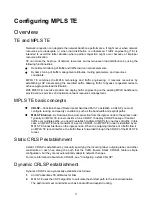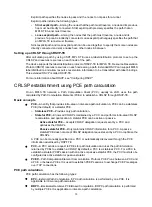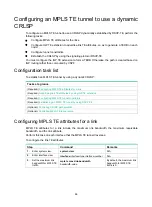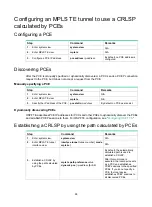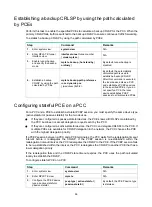
82
•
ITU-T Recommendation Y.1720,
Protection switching for MPLS networks
•
RFC 4655,
A Path Computation Element (PCE)-Based Architecture
•
RFC 5088,
OSPF Protocol Extensions for Path Computation Element Discovery
•
RFC 5440,
Path Computation Element (PCE) Communication Protocol (PCEP)
•
RFC 5441,
A Backward-Recursive PCE-Based Computation (BRPC) Procedure to Compute
Shortest Constrained Inter-Domain Traffic Engineering LSP
•
RFC 5455,
Diffserv-Aware Class-Type Object for the Path Computation Element
Communication Protocol
•
RFC 5521,
Extensions to the Path Computation Element Communication Protocol (PCEP) for
Route Exclusions
•
RFC 5886,
A Set of Monitoring Tools for Path Computation Element (PCE)-Based Architecture
•
draft-ietf-pce-stateful-pce-07
MPLS TE configuration task list
To configure an MPLS TE tunnel to use a static CRLSP, perform the following tasks:
1.
Enable MPLS TE on each node and interface that the MPLS TE tunnel traverses.
2.
Create a tunnel interface on the ingress node of the MPLS TE tunnel, and specify the tunnel
destination address—the address of the egress node.
3.
Create a static CRLSP on each node that the MPLS TE tunnel traverses.
For information about creating a static CRLSP, see "Configuring a static CRLSP."
4.
On the ingress node of the MPLS TE tunnel, configure the tunnel interface to use the created
static CRLSP.
5.
On the ingress node of the MPLS TE tunnel, configure static routing, PBR, or automatic route
advertisement to direct traffic to the MPLS TE tunnel.
To configure an MPLS TE tunnel to use a CRLSP dynamically established by RSVP-TE, perform the
following tasks:
6.
Enable MPLS TE and RSVP on each node and interface that the MPLS TE tunnel traverses.
For information about enabling RSVP, see "Configuring RSVP."
7.
Create a tunnel interface on the ingress node of the MPLS TE tunnel. On the tunnel interface,
specify the tunnel destination address (the egress node IP address), and configure MPLS TE
tunnel constraints (such as the tunnel bandwidth constraints and affinity).
8.
Configure the link TE attributes (such as the maximum link bandwidth and link attribute) on
each interface that the MPLS TE tunnel traverses.
9.
Configure an IGP on each node that the MPLS TE tunnel traverses, and configure the IGP to
support MPLS TE. Then, the nodes can advertise the link TE attributes through the IGP.
10.
On the ingress node of the MPLS TE tunnel, configure RSVP-TE to establish a CRLSP based
on the tunnel constraints and link TE attributes.
11.
On the ingress node of the MPLS TE tunnel, configure static routing, PBR, or automatic route
advertisement to direct traffic to the MPLS TE tunnel.
To configure an MPLS TE tunnel to use a PCE-calculated path to establish a CRLSP, perform the
following tasks:
12.
Enable MPLS TE and RSVP on each node and interface that the MPLS TE tunnel traverses.
For information about enabling RSVP, see "Configuring RSVP."
13.
Specify an LSR as a PCE and configure an IP address for the PCE.




